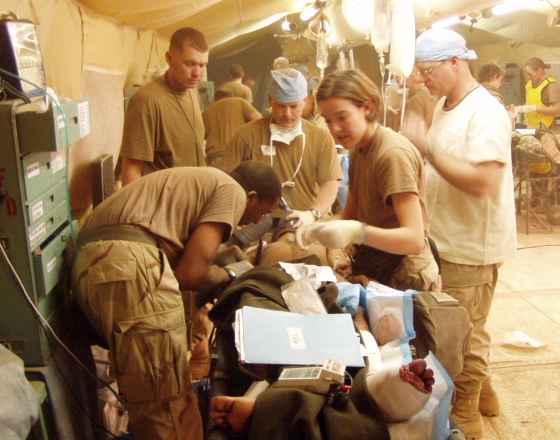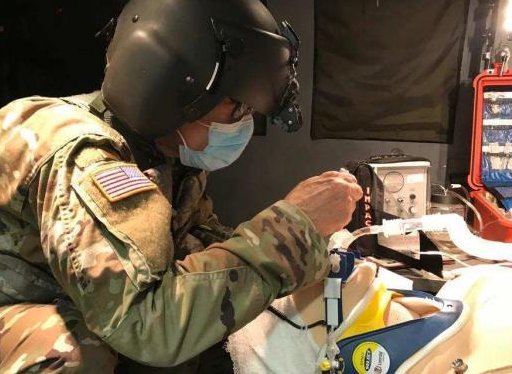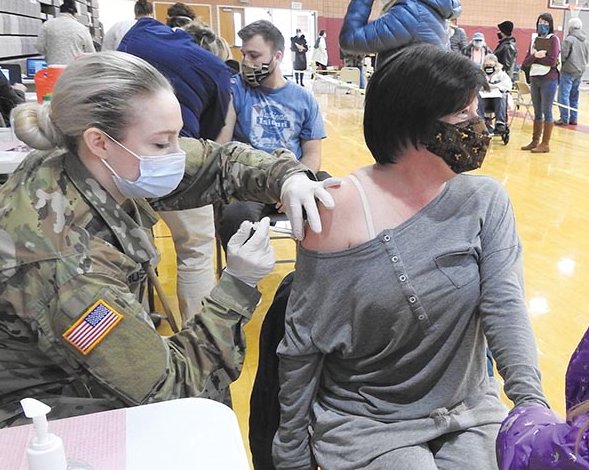Highlights in the History of the Army Nurse Corps, 2000 to Present
With bright hopes in the new millennium, the Army Nurse
Corps continued their expert
performance at home and in support of worldwide missions.
 On September 11, 2001, when the deadliest terrorist attack in US history occurred, Army nurses assigned at the Pentagon and throughout Washington DC rallied to help the injured. In response to the attacks, nurses mobilized for military operations in Afghanistan and Iraq. Army active duty, reserve and national guard nurses cared for
On September 11, 2001, when the deadliest terrorist attack in US history occurred, Army nurses assigned at the Pentagon and throughout Washington DC rallied to help the injured. In response to the attacks, nurses mobilized for military operations in Afghanistan and Iraq. Army active duty, reserve and national guard nurses cared for  more than 50,0000 military, host nation and enemy insurgents under harsh conditions in remote, dangerous locations in the longest war of our annals. They contributed significantly to the success of the multinational operations and worked collaboratively with coalition, Afghan, and Iraqi healthcare professionals.
more than 50,0000 military, host nation and enemy insurgents under harsh conditions in remote, dangerous locations in the longest war of our annals. They contributed significantly to the success of the multinational operations and worked collaboratively with coalition, Afghan, and Iraqi healthcare professionals.
 Nursing practice evolved to meet the medical requirements of the war. Nurses who were attached to far-forward surgical teams resuscitated critically injured warriors with a balanced mix of blood products and provided anesthesia for damage control surgery. They served on fixed-wing and rotary wing aircraft, transporting severely injured casualties
Nursing practice evolved to meet the medical requirements of the war. Nurses who were attached to far-forward surgical teams resuscitated critically injured warriors with a balanced mix of blood products and provided anesthesia for damage control surgery. They served on fixed-wing and rotary wing aircraft, transporting severely injured casualties  to higher levels of care. Family Nurse Practitioners were assigned to multiple roles, whether running sick call, treating trauma patients, or doing wound closure for operative patients. Army nurses were instrumental in the formation and use of the Department of Defense Trauma Registry that contains information about every trauma patient treated at an advanced theater facility. This formal documentation of injury patterns, for instance, led to improvements in personal protective equipment, tourniquet development, and burn care.
to higher levels of care. Family Nurse Practitioners were assigned to multiple roles, whether running sick call, treating trauma patients, or doing wound closure for operative patients. Army nurses were instrumental in the formation and use of the Department of Defense Trauma Registry that contains information about every trauma patient treated at an advanced theater facility. This formal documentation of injury patterns, for instance, led to improvements in personal protective equipment, tourniquet development, and burn care.
Since June 2003,
Army nurse case managers have been engaged in warrior care efforts, when as a
result of the wars in Iraq and Afghanistan the demand for support and
assistance of wounded, ill, and injured service members began increasing
exponentially. Their efforts have greatly facilitated the transition of these
patients. In 2010, these officers supervised care of over
9,000 service members and oversaw the transfer of over 8,500 military
personnel back to duty or to become productive veterans.
 In
response to the COVID-19 crisis, Army nurses have cared for military,
dependents and retired beneficiaries in military hospitals, and clinics through
in person and virtual appointments. They have deployed throughout the country
to help beleaguered civilian hospital staffs. They also managed or performed
contact tracing for individuals with confirmed or suspected infections.
In
response to the COVID-19 crisis, Army nurses have cared for military,
dependents and retired beneficiaries in military hospitals, and clinics through
in person and virtual appointments. They have deployed throughout the country
to help beleaguered civilian hospital staffs. They also managed or performed
contact tracing for individuals with confirmed or suspected infections.
In the eloquent words of Army nursing historian Colonel (Retired) Mary T. Sarnecky,
“Given the storied history of achievements, patriotism, and selfless
dedication, the Army Nurse Corps expects to carry on its unbroken line of
professional service and shall adapt its knowledge and skills to meet the
challenges of the future.”
Photos
|
Left from top:
Painting of an F-16 of the North Dakota Air Guard 119th Fighter Wing
on combat air patrol over the Pentagon on 11 September 2001
Triage in progress during an influx of casualties at the 212th Surgical Hospital
Michigan National Guard AN assists in Covid-19 immunizations in Alpena, MI |
Right from top:
The 212th Surgical Hospital in Iraq
Army Nurse trains to provide in-flight care |
Text by ANCA Historian COL (Ret.) C. J. Moore; Photos courtesy of the Army Medical Department Center of History and Heritage, Office of The Surgeon General, US Army; and The Alpena News